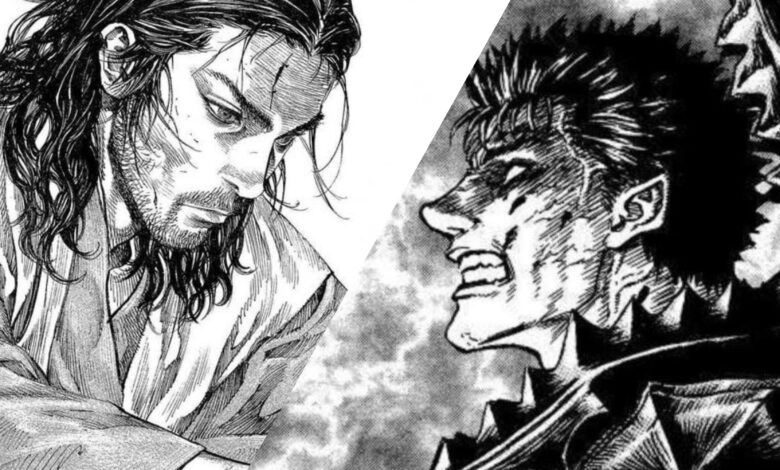Vagabond Manga Plot Summary: A Deep Dive into the Samurai Saga

Introduction
Vagabond Manga, created by Takehiko Inoue, stands as a monumental achievement in the world of manga. Its rich narrative and intricate art style have captivated audiences worldwide, securing its place as one of the most influential manga series of all time. This article delves into the origins, storyline, artistic brilliance, thematic depth, and lasting impact of Vagabond Manga, offering a thorough exploration for both new readers and long-time fans.
The Origins of Vagabond Manga
Creation and Concept
Vagabond was first published in 1998, drawing inspiration from Eiji Yoshikawa’s classic novel Musashi. The manga was born out of Takehiko Inoue’s fascination with the legendary samurai Miyamoto Musashi. Inoue, known for his previous success with Slam Dunk, approached Vagabond with a vision to blend historical accuracy with a deep, character-driven narrative. His goal was to portray Musashi’s journey not just as a series of battles, but as a profound exploration of the human condition and personal growth.
The concept behind Vagabond was ambitious. Inoue sought to capture the essence of samurai culture while also providing a psychological and philosophical depth to Musashi’s character. The manga presents Musashi’s quest for mastery and self-discovery, reflecting Inoue’s meticulous research and creative adaptation of Yoshikawa’s novel. This unique approach set Vagabond apart from other samurai-themed stories and helped establish its critical acclaim.
Publication History
The manga debuted in Weekly Morning, a popular Japanese magazine, and quickly garnered attention for its detailed artwork and compelling story. Over the years, Vagabond has seen numerous editions and translations, expanding its reach beyond Japan. The English translation by Viz Media has played a significant role in introducing the series to a global audience, further solidifying its international reputation.
The publication history of Vagabond reflects its evolving popularity and influence. Despite its initial success, the series experienced intermittent publication due to Inoue’s commitment to maintaining high artistic standards. This dedication, while leading to long waits between volumes, has only heightened the anticipation and appreciation among fans.
Plot and Storyline
Overview of the Main Plot
The central storyline of Vagabond follows Miyamoto Musashi’s transformation from a brash, aimless youth into a legendary swordsman. The narrative begins with Musashi’s participation in the Battle of Sekigahara, which sets the stage for his journey of self-discovery. Throughout the series, Musashi’s path is marked by intense duels, philosophical reflections, and encounters with various historical figures.
As Musashi travels across Japan, he confronts not only formidable opponents but also his own inner demons. The manga intricately weaves his personal growth with historical events, creating a rich tapestry of drama and action. Each arc of the story adds depth to Musashi’s character and explores different facets of his quest for mastery and meaning.
Key Characters
The character development in Vagabond is both nuanced and profound. Musashi, portrayed with great depth and complexity, evolves from a raw and rebellious warrior into a disciplined and introspective figure. His interactions with other characters, such as Sasaki Kojiro, add layers to his journey and highlight various philosophical and moral dilemmas.
Sasaki Kojiro, Musashi’s primary rival, is another pivotal character. His skills and ideology contrast sharply with Musashi’s, creating a dynamic interplay that drives much of the narrative tension. The development of these characters is central to the story’s exploration of themes like honor, conflict, and personal growth.
Art and Style
Artistic Approach
Takehiko Inoue’s art in Vagabond is celebrated for its realism and expressive detail. The manga’s visual style captures the raw intensity of samurai combat and the subtle nuances of character emotions. Inoue’s use of ink and brush techniques brings a dynamic quality to the artwork, creating a sense of movement and fluidity that enhances the storytelling.
The art style of Vagabond is distinguished by its meticulous attention to historical accuracy and its ability to convey deep emotional and psychological states. Inoue’s portrayal of the samurai era is not only visually striking but also immersive, providing readers with a vivid sense of the time and culture depicted in the manga.
Visual Impact
The impact of Inoue’s artwork extends beyond mere aesthetics. The detailed illustrations play a crucial role in enhancing the narrative, adding layers of meaning and atmosphere to the story. Key scenes, such as Musashi’s epic duels, are rendered with such intensity and precision that they become unforgettable moments in the reader’s experience.
The visual storytelling in Vagabond complements its written narrative, creating a cohesive and engaging experience. Inoue’s ability to balance action with introspection through his art makes the manga a compelling read and a significant contribution to the genre.
Themes and Symbolism
Major Themes
Vagabond explores several profound themes that resonate with readers. Honor and duty are central to the narrative, reflecting the samurai code and Musashi’s personal struggles. The manga delves into the concept of personal growth, portraying Musashi’s journey as a quest for self-improvement and enlightenment.
Isolation and solitude also feature prominently in the story. Musashi’s journey is marked by periods of loneliness and introspection, highlighting the psychological and emotional challenges of his path. These themes are explored through Musashi’s interactions, his inner thoughts, and the various obstacles he faces.
Symbolism in Vagabond
Symbolism in Vagabond enhances the thematic depth of the story. The recurring motifs of swords and battles symbolize the conflict between personal ideals and societal expectations. The manga also uses natural elements, such as landscapes and weather, to reflect characters’ emotional states and narrative shifts.
The symbolism in Vagabond adds layers of meaning to the story, inviting readers to explore the deeper implications of Musashi’s journey. This aspect of the manga contributes to its rich and thought-provoking nature, making it a rewarding read for those interested in both narrative and thematic analysis.
Reception and Legacy
Critical Acclaim
Vagabond has received widespread acclaim for its artistic and narrative excellence. The series has won several awards, including the Kodansha Manga Award, and has been praised by critics for its compelling storytelling and intricate artwork. The manga’s ability to blend historical accuracy with philosophical depth has earned it a respected place in the manga canon.
The critical reception of Vagabond reflects its impact on both the manga industry and its readers. The series has been lauded for its contribution to the samurai genre and its influence on contemporary manga storytelling.
Influence on Manga and Anime
The influence of vagabond manga extends beyond its own pages. The manga has inspired numerous works in the samurai genre, impacting both manga and anime creators. Its depiction of the samurai ethos and its innovative storytelling techniques have set a high standard for future works in the genre.
Vagabond has also influenced popular culture, with references and homages appearing in various media. The series’ legacy continues to shape the portrayal of samurai and historical narratives, cementing its place as a seminal work in the world of manga.
Conclusion
Vagabond Manga is a remarkable fusion of historical narrative and artistic brilliance. Takehiko Inoue’s dedication to portraying the samurai era with depth and authenticity has resulted in a series that is both visually stunning and thematically rich. Its exploration of honor, personal growth, and philosophical dilemmas makes it a timeless piece of literature that continues to resonate with readers.
The manga’s impact on the genre and its influence on contemporary works attest to its significance in the world of manga. As Vagabond remains a benchmark for excellence, its legacy endures, offering readers an unforgettable journey through the world of samurai.




